Posts Tagged ‘FDR’


“Your Excellency,” begins Pope Pius XII’s letter to Franklin Roosevelt dated May 18, 1943. “Almost four years have now passed since, in the name of the God the Father of all and with the utmost earnestness at Our command, we appealed to the responsible leaders of peoples to hold back the threatening avalanche of international strife and to settle their differences in the calm, serene atmosphere of mutual understanding.”
The Pope’s August 1939 appeal for a serene atmosphere of mutual understanding could certainly not be established after Nazi boots crossed into Poland the very next month. In his May 1943 letter, Pope Pius relates, with bitter taste, the tidal wave of destruction, despair and disorder that was then washing over the world.
It is in the same letter, the leader of the Catholic faith prays that Roosevelt understands that a bombardment of Rome would undoubtedly dislodge from human civilization the “many treasured shrines of Religion and Art,” that were housed within the city.
This appeal to effectively make Rome an open city failed. Roosevelt was not deaf to the Pope’s question of Rome and the Vatican, reassuring the Pope that bombing efforts would be concentrated upon military targets: “[if] it should be found necessary for Allied planes to operate over Rome, our aviators are thoroughly informed as to the location of the Vatican and have been specifically instructed to prevent bombs from falling within Vatican City.
Rome was eventually declared an open city by her defenders in August of 1943, after the Allied bombing campaign had ceased. The city was captured by the Allies in June of 1944.
The copious correspondence between President and Pontiff would continue after the Allied bombings of Italy, ending with Roosevelt’s untimely death.
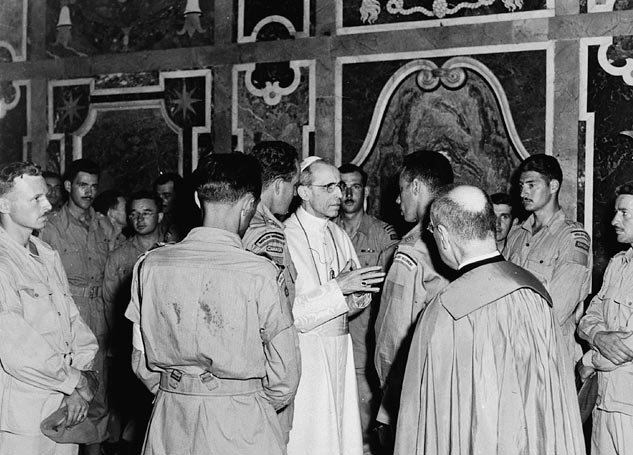
Members of the Canadian Royal 22e Regiment in audience with Pope Pius XII. Library and Archives Canada image.
Posted by Ryan Casalino, Interactive Content Intern.

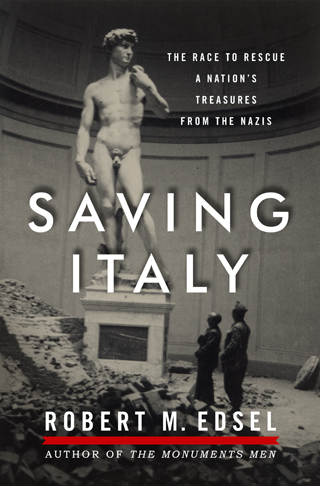 Meet the Author – Robert Edsel presents “Saving Italy: The Race to Rescue a Nation’s Treasures from the Nazis”
Meet the Author – Robert Edsel presents “Saving Italy: The Race to Rescue a Nation’s Treasures from the Nazis”
Thursday, May 30, 2013
5:00 pm Reception | 6:00 pm Presentation | 7:00 pm Book Signing
US Freedom Pavilion: The Boeing Center
When Hitler’s armies occupied Italy in 1943, they also seized control of mankind’s greatest cultural treasures. As they had done throughout Europe, the Nazis could now plunder the masterpieces of the Renaissance, the treasures of the Vatican, and the antiquities of the Roman Empire.
On the eve of the Allied invasion, General Dwight Eisenhower empowered a new kind of soldier to protect these historic riches. In May 1944 two unlikely American heroes — artist Deane Keller and scholar Fred Hartt — embarked from Naples on the treasure hunt of a lifetime, tracking billions of dollars of missing art, including works by Michelangelo, Donatello, Titian, Caravaggio, and Botticelli.
With the German army retreating up the Italian peninsula, orders came from the highest levels of the Nazi government to transport truckloads of art north across the border into the Reich. Standing in the way was General Karl Wolff, a top-level Nazi officer. As German forces blew up the magnificent bridges of Florence, General Wolff commandeered the great collections of the Uffizi Gallery and Pitti Palace, later risking his life to negotiate a secret Nazi surrender with American spymaster Allen Dulles.
Saving Italy brings readers from Milan and the near destruction of The Last Supper to the inner sanctum of the Vatican and behind closed doors with the preeminent Allied and Axis leaders: Roosevelt, Eisenhower, and Churchill; Hitler, Göring, and Himmler.
Robert M. Edsel is the author of the non-fiction books, Rescuing Da Vinci and The Monuments Men: Allied Heroes, Nazi Thieves and the Greatest Treasure Hunt in History, as well as the forthcoming book Saving Italy, to be published in Spring 2013. He is the co-producer of the documentary film, The Rape of Europa, and Founder and President of the Monuments Men Foundation for the Preservation of Art. In January 2012 George Clooney announced he would write, direct and star in the film version of Mr. Edsel’s book, The Monuments Men.
RSVP TO THE EVENT NOW



In the years 1939-1941, at the behest of President Franklin Roosevelt upon urging from retailers, Thanksgiving was celebrated a week earlier, on the third Thursday in November rather than the fourth. As a result, some referred to the earlier celebration not as Thanksgiving, but as Franksgiving. The week change was intended as an economic stimulus measure that would create a longer Christmas shopping season and increase retail in the time of the Great Depression. Some states refused the change and celebrated at the usual time, while a few states celebrated both dates.
For the first Thanksgiving during WWII, in 1942, Roosevelt returned the holiday to its traditional week. The hit 1942 film, Holiday Inn, remarked on the confusion surrounding the date of that year’s Thanksgiving—even the turkey is confused. Happy Thanksgiving!
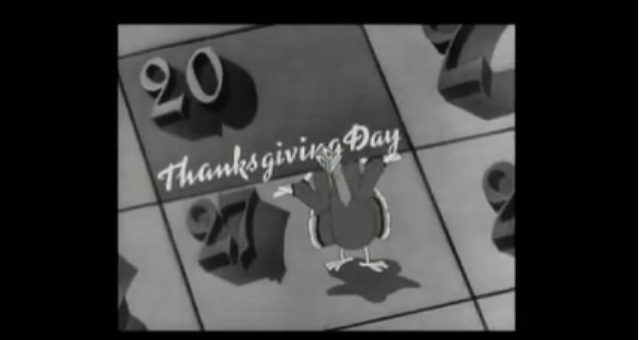
Click here to watch the Thanksgiving scene from Holiday Inn.
Post by Curator Kimberly Guise.



Predicting the outcome of presidential elections has evolved considerably since the days of FDR. While all polling relies on some form of sampling, the method employed can have a dramatic effect on the accuracy in projecting the next commander-in-chief. Statistician Dr. George Gallup, founder of the American Institute of Public Opinion, pioneered scientific methods for measuring public opinion. His method, known as The Gallup Poll, received national recognition by accurately predicting FDR’s win in 1936 from the replies of only 50,000 respondents. Gallup’s results were in direct opposition to Literary Digest’s polling prediction of Roosevelt’s defeat based on over two million mailed questionnaires.
FDR’s 1936 Reelection
Literary Digest made two major errors in sampling the U.S. electorate in 1936. First, they mailed questionnaires to automobile owners and magazine and telephone subscribers, a group not representative of the entire voting population during the Great Depression when many Americans could not afford to purchase a car or pay for magazines. Second, Literary Digest asked respondents to return their questionnaire by mail, essentially selecting for voters who had strong feelings of dissatisfaction with the current president.
So how did Gallup manage to accurately predict the outcome of the 1936 election using a sample one quarter the size of Literary Digest? Gallup used quota sampling to poll groups of people who reflected the overall composition of the electorate. The American Institute of Public Opinion sent hundreds of interviewers all of the country, each given quotas for different types of respondents based on multiple factors like class, gender, and location.
Gallup’s Hiccups
Gallup successfully predicted FDR’s subsequent bids for the White House in 1940 and 1944 until the organization notoriously failed to predict Truman’s 1948 victory. Several factors caused Gallup’s error in the 1948 election including two third-party candidates, continued use of quota sampling rather than random sampling, and ending poll collection a full two weeks before Election Day.
After 1948 Gallup extended polling to Election Day and replaced quota sampling with random sampling in an effort to eliminate interviewer bias. This method requires a much longer data collection period of four to six weeks including repeated efforts to find difficult-to-reach voter demographics. While applauded for transparency today, Gallup is sometimes criticized for their slow response to electoral change, like waiting until 2008 to add cell phone polling, finally reaching households without landline telephone service.
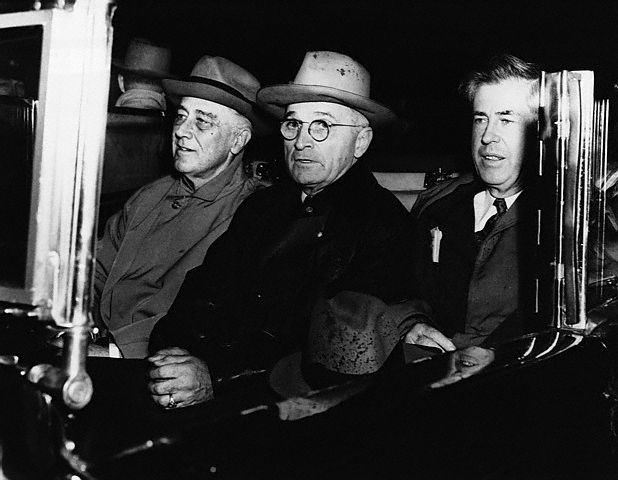
President Roosevelt and running mate Truman campaigning in 1944 for FDR’s unprecedented fourth term. Photo AP.
Posted by Annie Tete, STEM Education Coordinator at The National WWII Museum.



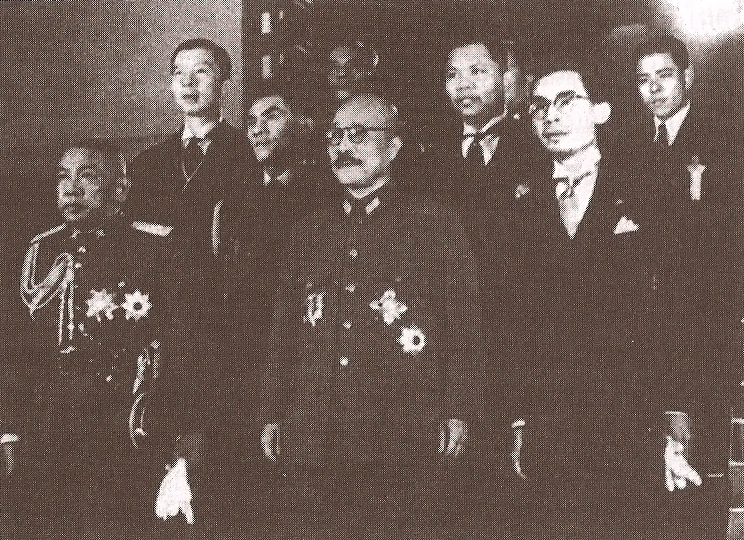
Photograph of Phot Phahonyothin (far left) with Hideki Tojo (center) in Tokyo 1942)
On this day in 1941, Thailand allied with Japan. Thailand was valuable for the Axis powers, as their airfields, ports, and railways would be instrumental in planned invasions of Malaya and Burma. The partnership was not necessarily an equal one; their alliance was the result of the December 8 Japanese invasion of Thailand after failed negotiations, the Thai resistance lasting only hours before a ceasefire was declared. Like many countries, Thailand joined the Axis powers because of military pressure.
Why countries joined the Axis or the Allies was complex, often rooted in many different factors, such as how much military power that country held, what political system they followed, and where they were located geographically. When trying to understand the complicated course of WWII, it is helpful to know the main players and their goals. So, who were the Axis powers and who were the Allies? (more…)



December 7, 1941, is a date which retains its unique power in the national consciousness of the American people because it marks our entryway into the Second World War and ultimately the pathway to the dominant position of the United States in world affairs, the Pax Americana of the twentieth century. The Japanese attack decisively ended American neutrality and our efforts to isolate the nation from the previous decade of troublesome world affairs. To many, it is the day the United States shed its innocence and naiveté, and shouldered the burdens of world leadership.
For most Americans, however, the Japanese attack was a surprising gateway to this destiny. Events in remote Asia were not seen as an immediate threat to the United States at the end of 1941. Instead, it seemed more likely that the United States would be drawn into war with Nazi Germany, as the American convoys carrying Lend-Lease to Great Britain came under fire from the German navy. Instead, war came to Americans in an unanticipated, blinding flash from across the Pacific, an attack that succeeded beyond the imagination of its planners in many respects, an attack that caught the American military unawares and in an embarrassed state and exposed condition. The story of the missed signs, misinterpretations, misunderstandings and many ironic passages which all combined to lead to Pearl Harbor is a vast tapestry.
(more…)



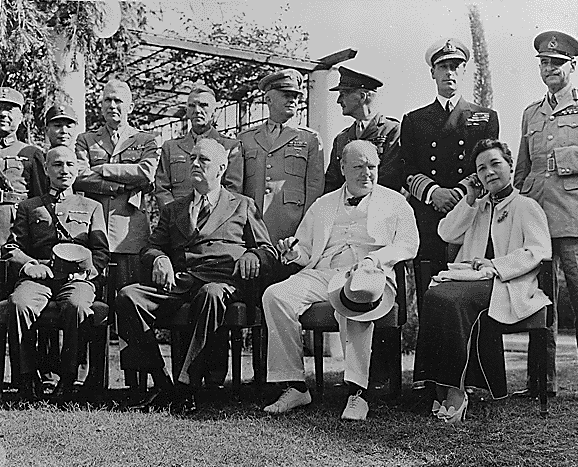
Kai-shek, Roosevelt, Churchill, and Madame Chiang seated at the Cairo Conference in November 1943. Courtesy of the National Archives.
Today in 1943, President Roosevelt, Prime Minister Churchill, and Generalissino Kai-shek convened in Cairo, Egypt to reevaluate Allied tactics on fighting and defeating Japan, and the subsequent actions that would be taken once the Pacific War had been won. The Cairo Communique, as it became known, was released to the public on 1 December 1943 and outlined goals for post-war Japan.
(more…)



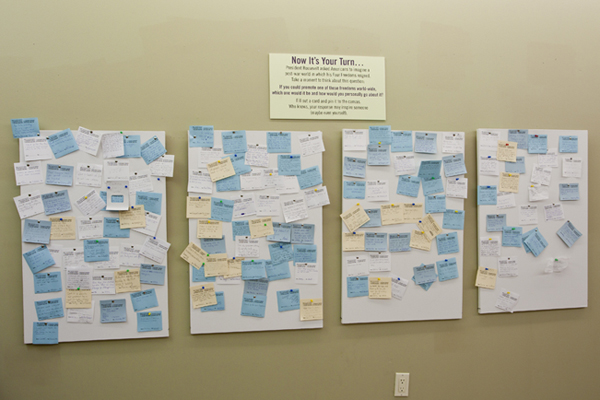
Roosevelt, Rockwell and the Four Freedoms: America’s Slow March From Isolation to Action, the Museum’s special exhibit focusing on the years leading up to World War II, recently closed. The exhibit explored, with the help of Gallup polls from the times, the evolving views of the American public as world events unfolded in the late 1930s and early 1940s.
President Franklin Delano Roosevelt, in his January 1941 State of the Union speech, envisioned four essential human freedoms that he believed could, and should, be gained for all persons everywhere – Freedom of Speech, Freedom from Fear, Freedom of Worship, and Freedom from Want. Roosevelt, in enunciating these to the American public, was providing a moral bedrock on which to build a road to participation in World War II. He was certain of the righteousness of the cause, and hoped to convince Americans to share that belief.
During the exhibit’s run, we solicited feedback from Museum visitors about those same Four Freedoms. Roosevelt’s stated hope was that a victorious post-war world would encompass all of them. They are certainly among the highest of human aspirations. We wanted to know if Museum visitors would wish to help to bring them about in today’s world, and if so, what work would be needed by the individual visitor to accomplish these lofty goals.
(more…)



On October 9, 1941, one of the most important, lonely and secret decisions in the course of the Second World War was made by President Franklin D. Roosevelt. In a small meeting with only Vice President Henry Wallace and the head of the National Defense Research Committee Vannevar Bush present, Roosevelt committed the United States government to embark upon a program of intensified research into the feasibility of a fission bomb. The major questions of how much money, construction projects, personnel, and administrative structures needed to build an atomic bomb were not decided at this meeting. In Vannevar Bush, Roosevelt was giving the green light to a man he trusted to develop those frameworks as needed, and Roosevelt was aware that Bush would use Presidential authority to aggressively push the project forward. The United States was still technically a neutral nation in October 1941, yet Roosevelt became the first national leader to commit his nation to the effort to achieve a nuclear device. In so doing, he also decisively changed the nature of the relationship between American government and American science, a cultural change that has persisted to the present day.
Once begun down this pathway, the Americans would be the first to successfully detonate a nuclear bomb with the Trinity test in the desert of New Mexico on July 16, 1945. But there was nothing inevitable in the story of what would be officially christened as the Manhattan Project in August, 1942. Before the culmination of the technical project, however, Roosevelt’s decision established important political parameters for the future of the nation and the world long after the end of the war. He did not wish to consult on nuclear issues with the American Congress which voiced the democratic concerns of the public, the military forces which would use the weaponry, or the scientists who developed and implemented the technology. He did not wish to develop the technology in an international effort with the Allies (although it will be seen that Great Britain made a deep contribution to Roosevelt’s decision to pursue the project in October 1941). Almost instinctively, Franklin Roosevelt reserved all major policy aspects of the atomic bomb to himself and the American presidency.
(more…)



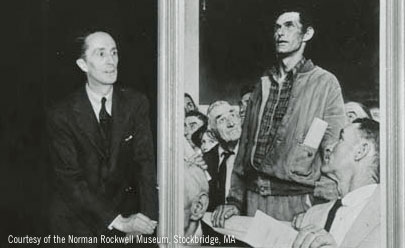
Picture this scene: a man stands up to speak his mind at a community meeting. He’s not a town leader or a wealthy businessman. He’s a farmer, or a truck driver, or maybe a factory worker. But at this civic gathering, he delivers his opinion with the knowledge that his right to speak his mind is ingrained in the law of the land. It’s a simple scene, but one that Norman Rockwell seared into the American consciousness as part of his 1943 “Four Freedoms” series.
Today, the Museum opens a special exhibit titled Roosevelt, Rockwell, and the Four Freedoms: America’s Slow March from Isolation to Action (September 2—November 13). This exhibit explores a lesser-known side of WWII history—the time period before Pearl Harbor, when Americans debated what to do about the wars in Europe and Asia. From the Neutralities Acts passed in the mid 1930s to “Cash and Carry” to the Lend Lease program, American politicians, newspaper editors, community leaders, and everyday Americans argued between isolation and intervention, between staying out and helping out. As President Roosevelt became convinced that the United States must aid Great Britain in its solitary fight against Nazi Germany, he knew he needed to provide a moral justification to persuade his fellow Americans to go along. In his January 6, 1941, State of the Union Address, he spoke of a post-war world where four freedoms reigned: Freedom of Speech, Freedom of Worship, Freedom from Want, and Freedom from Fear. That speech and the ever-more frightening realities on the ground in Europe helped usher in a more aggressive anti-Nazi, pro British foreign policy. Two years later, with the United States in the war, popular American artist Norman Rockwell turned Roosevelt’s Four Freedoms into four iconic paintings, which in turn were turned into four of the best known American propaganda posters of WWII.
Come see these original posters, a timeline of pre-war American foreign policy, and a provocative audio-visual presentation that will get you thinking about whether Mr. Roosevelt’s vision has come true or not.
Find out more about “Roosevelt, Rockwell and the Four Freedoms: America’s Slow March from Isolation to Action.”
Learn more about the Public Programming that accompanies this exhibit, including film screenings and lectures.
This post by Director of Education and co-Curator of the exhibit Kenneth Hoffman.



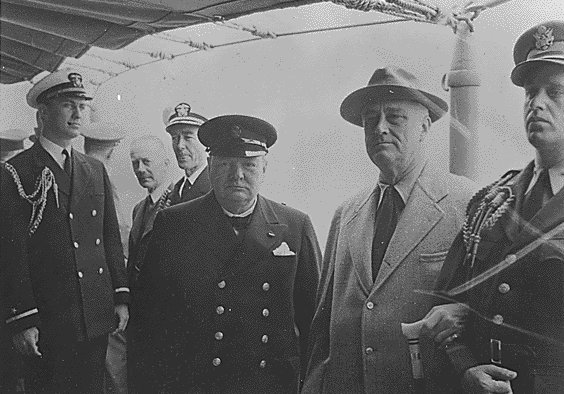
With the 70th anniversary of Pearl Harbor on the horizon, we turn our attention to the eve of US involvement in the war that changed the world. This entry by the Museum’s Senior Director of History & Research, Keith Huxen, is just one of many historical essays on 70th anniversaries we will be posting in coming years. You can also keep up with significant dates by following the Museum’s Twitter feed, @wwiitoday.
The Atlantic Charter: 70th Anniversary, August 14, 1941
In the summer of 1941 the historical pathway of the Second World War was rapidly changing. In Asia, Japan found herself still struggling after four years to complete and consolidate her conquests in China without recourse or access to the raw materials spread further across the Southeast Asian archipelago. Pressure in the European war was also reaching critical mass. Great Britain, having survived the previous summer by fending off Operation Sea Lion, Hitler’s planned invasion across the English Channel, had continued to fight Germany alone. Unable to complete Britain’s defeat by late October 1940, Hitler gambled and unleashed Operation Barbarossa, the German invasion and double-cross of the Soviet Union. The Germans believed that total victory over the USSR could be completed in six months. Germany’s gamble would achieve four great objectives: Soviet defeat would rob Britain of her last potential European ally and force Britain to a separate peace; Hitler would eliminate the Soviet Communist regime which he regarded as his great ideological enemy; Hitler would acquire through invasion the vast Lebensraum or eastern living space in Ukraine where he intended to build a purely Aryan empire; and last, as the German army acquired and controlled the territories of Eastern Europe, Hitler would gain control of two-thirds of Europe’s Jewish population (along with other racial undesirables in the Nazi lexicon) which he intended to extinguish from European life. Unleashed on June 22, 1941, the Nazi invasion and strategy appeared to have a good chance of success as the Nazis drove deep into Soviet territories.
Despite a long and dedicated political opposition to Communism, Britain’s Prime Minister Winston Churchill immediately welcomed Joseph Stalin and the Soviets as an ally in the fight against Nazism. When questioned on his political pivot, Churchill famously observed that “if Hitler invaded Hell, I would at least make a favorable reference to the Devil.”
(more…)



![]()
 Meet the Author – Robert Edsel presents “Saving Italy: The Race to Rescue a Nation’s Treasures from the Nazis”
Meet the Author – Robert Edsel presents “Saving Italy: The Race to Rescue a Nation’s Treasures from the Nazis”








